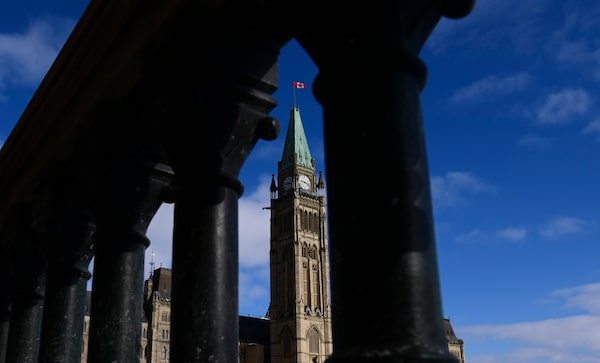
The Peace Tower on Parliament Hill in Ottawa on March 9, 2021.Sean Kilpatrick/The Canadian Press
Since the early days of the pandemic, the federal Liberal government has pointed to rock-bottom interest rates as a key reason why their spend-in-all-directions fiscal approach will not drive Canada into a debt wall.
In the fall economic statement, the Liberals asserted that its pandemic debts would be affordable, citing the precipitous decline in yields for the government’s 10-year bonds, a gauge not only of Ottawa’s borrowing costs, but also of the credit market’s belief that economic growth and inflation would be lukewarm for years to come.
The assumptions of a soft economy, and low interest rates, were also the basis for the Liberal plan for $70-billion to $100-billion in stimulus spending over the next three years. The arithmetic was simple: Large deficits would not be a problem, so long as the economy was growing faster than the government’s debt. In a world of ultralow interest rates, borrowing tens of billions to boost growth would pay off.
Those assumptions have been turned on their head, less than four months after the November update, and weeks ahead of the first pandemic-era federal budget. Economic growth in the fourth quarter was much stronger than expected, a trend that stretched into February, with employment growing much faster than expected. In the United States, a US$1.9-trillion stimulus package will help out not only the American economy, but also Canadian exporters as well.
“A lot has changed since then,” says Douglas Porter, chief economist at the Bank of Montreal.
Chief among those changes is the rapid run-up in the yields for the federal government’s 10-year Canada bonds since the start of the year, driven by the belief that the economy will rebound from its pandemic tailspin much faster than expected – and that inflationary pressures will also re-emerge sooner than previously thought.
Expectations of future inflation drive down the price of bonds since that reduces the real value of their interest payments. As the price of a bond falls, its yield rises. That’s what has been happening in 2021. Since Dec. 31, yields for the 10-year bond have more than doubled, rising to almost 1.43 per cent on Thursday from 0.67 per cent, as shown in the chart below.
The performance of bond markets in 2021 contrasts starkly with the government’s projections in its Nov. 30 economic update.
Then, the Liberals touted the steep drop in 10-year bond yields, which in late November sat at just 0.72 per cent, down by more than half from the start of 2020 (in part because of the Bank of Canada’s intervention in bond markets). And the government expected those low rates to persist for years: It forecast that the yields on 10-year bonds would rise only gradually over the next five years. Not only that, the government reduced its outlook for 10-year bond yields from what it had forecast in the July fiscal update.
However, the bond market has headed in the opposite direction, with yields surging past Ottawa’s forecast not just for this year, but also for 2022. Private banks are forecasting they will continue to increase, although at a slower pace.
That is potentially bad news for the federal deficit, if rates continue to run ahead of the government’s projections. In January, the Parliamentary Budget Officer wrote that a permanent increase in interest rates by 100 basis points (or one percentage point) would increase Ottawa’s debt costs by $4.5-billion in the first year and by $12.8-billion by the fifth year, as older debt matured and was rolled over at those higher rates.
Despite the recent rise, yields are still at relatively low levels, historically speaking. As the chart below shows, those yields (and Ottawa’s borrowing costs for long-term debt) are much lower than for much of the past two decades.
That means that Ottawa’s deficit arithmetic is diminished, but not destroyed, says Omar Abdelrahman, economist at TD Economics. Interest rates are still forecast to be lower than economic growth, keeping debt servicing costs at relatively low levels, he says. But markets will be looking for signs of medium-term fiscal discipline from Ottawa, Mr. Abdelrahman adds. “There has to be caution.”
Mr. Porter at BMO goes further, saying he believes that Ottawa’s case for continuing to spend heavily has “eroded heavily” because of the run-up in yields.
At the same time, Canada’s brightening economy lessens the need for massive stimulus spending by Ottawa, Mr. Porter says. Rather than take additional debt, the federal government could instead allow the billions sitting in the bank accounts of consumers and businesses to drive an economic recovery, with the stimulus spending package morphing into a contingency plan.
“My view is, consumers are aching to spend again,” he says.
The Liberals aren’t entirely discounting the power of that private-sector spending. Finance Minister Chrystia Freeland referred to those savings as “preloaded stimulus” in the November economic statement – but only in the context as a complement to the government’s spending plans. In comments to the House of Commons finance committee on Thursday, Ms. Freeland did not give any indication that the government intends to scale back its spending plans when asked about concerns about the size of the U.S. stimulus program. She did note that any assessment of stimulus spending should include not just its magnitude, but also how the government is spending.
Rebekah Young, director of fiscal and provincial economics at Bank of Nova Scotia, said she does not believe the government will step back from its stimulus-spending ambitions because of the increase in bond yields. “Bottom line, I don’t think it will be a significant deterrent.”
But Ms. Young said the government will be forced to change how it describes and justifies its spending program, given that the risk of further economic turbulence is fading – and the fiscal cushion of ultralow interest rates is diminishing.
Tax and Spend examines the intricacies and oddities of taxation and government spending.